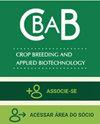全基因组关联研究揭示了番茄种质抗枯萎病的遗传位点
IF 1.1
4区 农林科学
Q2 Agricultural and Biological Sciences
引用次数: 5
摘要
本文章由计算机程序翻译,如有差异,请以英文原文为准。
Genome-wide association study revealed genetic loci for resistance to fusarium wilt in tomato germplasm
Abstract Tomato Fusarium wilt caused by Fusarium oxysporum f.sp. lycopersici (Fol) constrains tomato production worldwide. Three hundred forty tomato accessions were evaluated for Fusarium wilt resistance and single nucleotide polymorphisms (SNPs) associated with resistance. The disease resistance evaluation revealed that 15, 13, and 15 accessions were identified as Fusarium wilt resistant in Test 1, 2, and Mean data, respectively, with the disease severity index (DSI) ranging from 0-16.7%. A genome-wide association study (GWAS) identified SNPs associated with resistance. Eighteen common SNPs were detected in at least two tests and located on chromosomes 4, 6, 7, 9, and 12. Six unique significant SNPs were found in either Test 1 or 2, located on chromosomes 2, 4, and 7. Candidate genes associated with Fusarium wilt resistance were identified. Notably, two genes encoding leucine-rich repeat-like protein and disease-resistance protein were predicted from the two unique SNPs, solDsnp10606 and solDsnp6266, respectively.
求助全文
通过发布文献求助,成功后即可免费获取论文全文。
去求助
来源期刊
CiteScore
2.40
自引率
13.30%
发文量
25
审稿时长
6-12 weeks
期刊介绍:
The CBAB – CROP BREEDING AND APPLIED BIOTECHNOLOGY (ISSN 1984-7033) – is the official quarterly journal of the Brazilian Society of Plant Breeding, abbreviated CROP BREED APPL BIOTECHNOL.
It publishes original scientific articles, which contribute to the scientific and technological development of plant breeding and agriculture. Articles should be to do with basic and applied research on improvement of perennial and annual plants, within the fields of genetics, conservation of germplasm, biotechnology, genomics, cytogenetics, experimental statistics, seeds, food quality, biotic and abiotic stress, and correlated areas. The article must be unpublished. Simultaneous submitting to another periodical is ruled out. Authors are held solely responsible for the opinions and ideas expressed, which do not necessarily reflect the view of the Editorial board. However, the Editorial board reserves the right to suggest or ask for any modifications required. The journal adopts the Ithenticate software for identification of plagiarism. Complete or partial reproduction of articles is permitted, provided the source is cited. All content of the journal, except where identified, is licensed under a Creative Commons attribution-type BY. All articles are published free of charge. This is an open access journal.

 求助内容:
求助内容: 应助结果提醒方式:
应助结果提醒方式:


